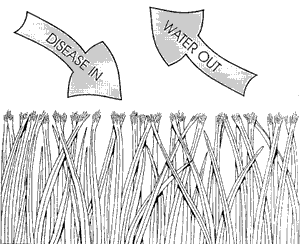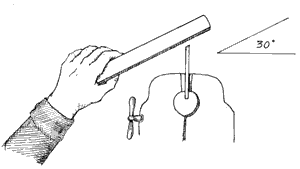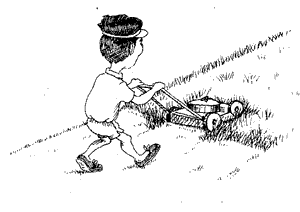Before Mowing
Have a Sharp Mower Blade
It is important to to have a sharp lawn mower blade on your machine at all times. Grass is always somewhat damaged and stressed when it is cut. However, cut with a sharp mower blade, individual leaf tips heal much more quickly and the grass plant remains healthy. Dull mower blades bludgeon the leaf tips, causing them to become frayed and turn gray, then brown. These brown mutilated tips provide a way for disease-producing organisms to infect grass plants.
 A dull blade requires 30% more power from a lawnmower engine than a sharp blade does.
A dull blade requires 30% more power from a lawnmower engine than a sharp blade does.
Replace the Blade – Do Not Have it sharpened : In the past we have recommended that you have your blade professionally sharpened or that you sharpen your blade yourself; no more. The modern mulching lawn mower blades are designed with important function performed by both sides of the blade. One side cuts the grass, but the other side is equally important in that it lifts the grass up into the mower bell. That “lift” side of the blade wears out just like the cutting edge, but it can’t be sharpened to fix that wear. So we strongly recommend that you replace your lawn mower blade every year, or at the very least, every two years.
Wear Proper Clothing and Protection
Mowing the lawn is not without risk. Thousands of yardeners are taken to hospital emergency rooms every year with lawn mower injuries. By dressing properly, you can minimize the danger:
Wear long pants to shield your bare skin from flying objects and sun, even though shorts may be a lot more comfortable in July. Avoid loose clothing or dangling jewelry that can snag on mower controls.


Don't mow the lawn in bare feet or in sandals. Wear sturdy, non-slip shoes that provide good traction and protection.
Consider ear protection while mowing your lawn. The noise level of a standard gasoline-powered lawn mower is high enough to cause some measurable hearing loss when a person is exposed to it for more than 30 minutes at a time. Do not rely on wads of cotton, or even ear plugs.
SEE THE TOOL SHED FOR SAFETY GLASSES AND EAR PROTECTION
Don’t Cut Wet Grass
If possible, cut the grass when it is completely dry. Walking on wet grass as you mow bruises it. Cutting it wet causes uneven mowing and messy clumps of clippings which tend to mat together and block light from the turf. Wet grass clippings accumulate in the bell of the mower, eventually jamming up the blade.
Try to avoid mowing during early morning hours when there is a heavy dew on the grass. It is tough to persuade lawn care services to do this. They need to cut on schedule, wet or not.
Check Gas and Oil Levels
As a matter of routine, it is wise to always check the status of the gas and oil in your mower before each mowing session. It really doesn't matter whether you run out of gas in the middle of mowing the lawn, but it is really very important to never run the mower when it is low on oil.
You are checking to see if the level of the oil is at the "full" level on the dip stick and if the oil is still a light brown color, rather than the dirty black color that indicates a need to change the oil entirely.
Check the Lawn Mower Maintenance file in Yardener's Tool Shed for more details.
